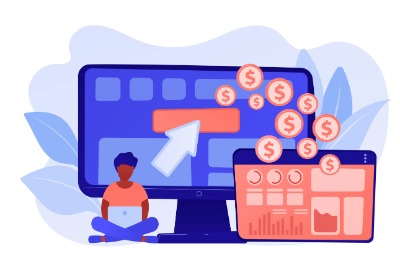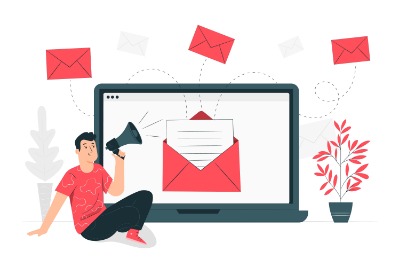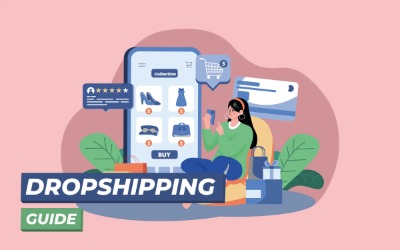Starting an online dropshipping business is one of the most popular ecommerce models today. The barriers to entry are low, it's easy to scale, and you don't have to worry about purchasing inventory upfront or managing shipping and fulfillment.
How to Start a Dropshipping Business?
If you're thinking about starting a dropshipping business in 2024, this step-by-step guide will walk you through everything you need to know. The infographic below provides a helpful visual overview of the key steps covered in this guide:
 Infographic by: ProfitProton
Infographic by: ProfitProton
1. Pick a Product Niche
The first step in starting your dropshipping journey is to select a product niche.
Selecting the right niche for your dropshipping business is one of the most important steps, though it can be challenging. Take the time to thoroughly research and analyze potential niche ideas.

Research different niche ideas to find one that fits these criteria:
-
Has high consumer demand and low competition from existing shops
-
Closely aligns with your own interests and knowledge
-
Has reliable suppliers who support dropshipping logistics
When you're enthusiastic about the products you sell, it will shine through in your marketing efforts and interactions with customers, making your business more appealing.
Thoroughly analyze tools like Google Trends, Amazon best sellers, and AliExpress to uncover trending or unique products that would work well.
It's best to avoid extremely saturated markets like phone cases unless you can offer something very differentiated.
2. Analyze Your Competition

Once you've selected a product niche, take time to study your potential competitors.
Understanding your competitors will help you identify gaps in the market and find unique selling points for your dropshipping store.
Look for successful stores within your niche, learn from their strategies, and find ways to differentiate your business.
Analyze their product offerings, pricing, marketing techniques, and customer service.
In pretty much any business, it’s often very effective to analyze what your competitors are doing and then improve upon it. This way, you can identify gaps in the market and develop your own unique approach that stands out from the crowd.
3. Choose a Supplier

Once you've settled on a product niche, the next step is to find reliable and profitable suppliers for your dropshipping business.
Selecting the right suppliers to fulfill orders is really important for providing smooth, timely delivery to customers.
When researching suppliers, prioritize those that:
-
Can ship out products quickly from a warehouse located close to your target customers
-
Have many positive reviews and a responsive customer service
-
Already integrate with Shopify or your chosen ecommerce platform
Initially, it's smart to stick to just a handful of suppliers while testing demand. This helps avoid over-committing. Sites like Oberlo and Spocket make it easy to find pre-vetted dropshipping suppliers.
Consider ordering samples from potential suppliers to test the quality of their products and the reliability of their shipping methods.
4. Build a Store

Now that you've chosen your product niche and suppliers, it's time to create your dropshipping storefront on Shopify!
Shopify simplifies the process with user-friendly tools and templates to design a professional online store. It's the go-to platform for launching a dropshipping business and has all the features you need.
Next, you need to purchase a domain name for your store.
.store extensions are typically cheaper, but .com can portray a more premium, professional look depending on your preference.
Choose an easy to remember name that can be turned into an identifiable brand. Buy the domain on Shopify or a platform like Namecheap, which you can connect to your store.
After securing your domain, select a visually appealing theme aligned with your brand identity. Consider reading this article to learn tips for choosing a fast, responsive theme that will improve your website's performance.
Customize it by adding your logo, product photos, color palette, and text. Import products, write compelling descriptions, set pricing, and integrate payment gateways and shipping methods.
Remember to optimize your store for mobile, as many customers will be browsing on their smartphones.
Also, don’t forget to include high-quality images and detailed product information to effectively showcase offerings.
For inspiration, check out a well-structured dropshipping store such as freshjuiceblender, which has an aesthetically pleasing layout, sharp images, and clear calls-to-action driving sales.
5. Promote Your Online Store

Now comes the fun part, driving traffic and getting visitors to your online store. An effective marketing strategy is essential to attract potential customers and boost your sales.
Let's explore some proven methods to promote your dropshipping store:
How to Get Visitors to Your Dropshipping Store?
Social Media

Social media is a powerful tool for connecting with your target audience and driving traffic to your online store.
-
Create business pages on TikTok, Instagram, and other platforms. Post engaging content like behind-the-scenes images or photos and videos showcasing your products.
-
Run occasional promotions and sales to generate buzz and get followers invested in your brand.
-
Form partnerships with influencers in your niche to tap into their existing audiences.
Each social media platform has its unique strengths and audience demographics. Adjust your content and marketing efforts to suit the platform you're using.
For example, Instagram is highly visual, making it ideal for showcasing product photos, while Twitter is excellent for engaging in real-time conversations with your audience.
Paid Ads

Investing in paid advertising can be an effective way to reach a broader audience and drive immediate traffic to your store.
-
Launch Google Shopping campaigns so your products appear in relevant searches.
-
Create Facebook, Instagram and TikTok ads optimized for driving conversions. Target audiences that resemble your existing customers.
-
Get the most bang for your buck by continually A/B testing elements like ad creative, placements, audiences, and more.
Start with a modest budget when experimenting with paid advertising. Monitor the performance of your ads and make adjustments as needed to optimize their effectiveness. Over time, you can increase your ad spend based on the results you achieve.
Email Lists

Building an email list is a powerful marketing technique for dropshipping businesses.
You can collect email addresses from visitors to your store and send them marketing emails with special offers, new product announcements, and exclusive discounts.
Offering a bait, such as a discount code or freebie, in exchange for signing up to your email list can encourage more people to subscribe.
Consider using the "Giveaways Technique" to gather a large email list of potential clients.
Host a giveaway for the product you're selling and ask participants to sign up with their email addresses. This technique can be highly effective, as you can grow your email list while generating interest in your products.
SEO

Search Engine Optimization (SEO) is essential for improving your store's visibility in search engine results.
-
Research relevant keywords and phrases people search when looking for your products. Free tools like AnswerThePublic can uncover this data.
-
Optimize your site architecture, URLs, titles, headings, and content specifically for those identified keywords.
-
Create long-form blog content and guides to rank for more in-depth queries.
-
Get backlinks from other websites to improve your site's domain authority and search engine rankings.
SEO is a long-term strategy that requires patience. It may take time to see significant results, but the effort is worth it as organic traffic can be a sustainable and cost-effective source of visitors.
FAQ
Why Start a Dropshipping Business?
Starting a dropshipping business comes with numerous benefits:
-
Low startup cost: You don't need to invest in inventory upfront, making it a cost-effective option for aspiring entrepreneurs.
-
Easy to set up: With e-commerce platforms like Shopify, you can launch your store quickly and easily, even without extensive technical knowledge.
-
Easy to scale: As your business grows, you can expand your product range and reach a broader audience without the limitations of physical inventory.
-
Passive income potential: Once your store is up and running, you can earn money while you sleep, as your suppliers handle order fulfillment.
-
Low risk: Since you're not purchasing inventory upfront, the risk of unsold products is minimized, reducing potential financial losses.
How Much Money Can You Make from Dropshipping?
The average dropshipping business makes around $500-2500 a month.
However, the potential earnings from dropshipping can vary based on several factors:
-
Product niche: Some niches may be more profitable than others due to higher demand and better profit margins.
-
Marketing strategies: Effective marketing campaigns can drive more traffic and lead to higher conversions.
-
Overhead costs: Minimizing operational costs can increase your profit margins.
-
Supplier partnerships: Establishing strong relationships with reliable suppliers can impact product availability and shipping times.
Your profit potential can improve over time as you refine your strategies and optimize your business. Stay adaptable and be willing to experiment to find what works best for your specific dropshipping store.
What Should I Consider When Choosing a Dropshipping Product?
When selecting a product for your dropshipping store, consider the following:
-
Market demand: Choose products with steady demand to ensure consistent sales throughout the year.
-
Profit margin: Look for products with healthy profit margins to make your business financially viable.
-
Competition: Evaluate the level of competition in your niche and identify ways to stand out and differentiate your offerings.
-
Product quality: Partner with reliable suppliers to ensure the quality of your products and maintain customer satisfaction.
Final Thoughts
Congratulations, you're now armed with the knowledge to start a dropshipping business in 2023!

Launching a profitable dropshipping business takes consistent effort but can pay off in the long run.
The keys are finding a winning niche, creating a well-optimized online storefront, securing reliable suppliers, and driving consistent traffic through marketing.
Use this comprehensive 2023 guide to help start your own successful shopify dropshipping side hustle this year.
Let us know if you have any other questions!

